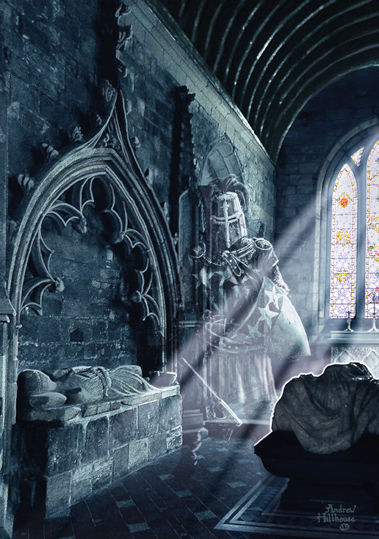
Midnight at St Bride’s – the Black Douglas.
The spirit of Sir James, the good or the Black Douglas, keeps a lonely vigil in the darkest hours of the night at St Bride’s Church, Douglas, South Lanarkshire. Here, his bones lie at rest in the ornately carved tomb and his heart lies sealed within a casket set into the floor. The small church of St Bride’s is usually locked but access can be obtained by knocking on the door of the key holder who lives nearby. When you consider the violent existence he was forced to endure during his turbulent and adventurous life, the last resting place of the Black Douglas always seems to me to radiate an enormous sense of peace and calm. The story of how his bones came to lie at rest, almost forgotten in an unknown little church in Scotland whilst, far, far away, the residents of a small town in Andalusia, Spain, continue to revere his name is an intriguing one.
As King Robert the Bruce lay dying he asked Sir James Douglas, his friend and lieutenant, to carry his heart into battle against "God's foes" as a token of his unfulfilled vow to go on crusade. When Bruce died in 1329, his heart was cut from his body and placed in a silver and enamelled casket which Sir James placed around his neck. Early in 1330, he set sail from Berwick upon Tweed, accompanied by seven other knights and twenty six squires to fulfil his solemn promise. The party stopped first at Flanders then sailed on to Seville where Sir James and his solemn relic were received by King Alfonso with great honour. At that time, Alfonso was preparing a campaign against the Muslims of the kingdom of Granada. Douglas and his company joined Alfonso's army which then set out for the frontier of Granada to besiege the castle of Teba. At some point during the siege, the Black Douglas met his end. Unfortunately, there are conflicting reports of his demise.
One account states that Douglas was killed as a result of making a premature attack upon the enemy over access to water supplies. Others state he died in the decisive Battle of Teba.
A more detailed account in the “Gran Cronica de Alfonso XI” states that Uthman, the Berber general in command of the Moorish forces who had ridden to relieve the siege of Teba, found himself unable to lure the Christians away from the besieged castle and commit them to battle. In frustration, he sent a body of cavalry to carry out a diversionary attack across the Guadalteba river. At the same time Uthman planned to circle round and attack the Christian camp in the rear in an attempt to destroy the besieging army's supplies. King Alfonso, however, had received intelligence of Uthman's intentions and kept most of his army back in camp while he sent a small force out to deal with the attack on the river. It is presumed that Douglas and his company were part of the force who remained behind in the camp. When Uthman arrived at the camp he found Alfonso's men armed and ready. He abandoned his attack and hastily rode to support his diversionary force on the river. By the time he arrived, however, he found his men had been unable to withstand the Christian assault and were already starting to fall back. Unable to prevent a general rout, his force was driven back in confusion towards their camp in the Turon valley, 10 miles to the south.
According to John Barbour's description of events, when the enemy broke, Sir James and his companions followed hard behind. Having outstripped most of his men in the pursuit, Douglas suddenly found himself far out in front with only a few of his followers around him. As he rode back to rejoin the main body, he saw Sir William St. Clair of Rosslyn surrounded by a body of Moors who had rallied and counterattacked. With the few knights who were with him, Douglas turned aside to attempt a rescue but, outnumbered twenty to one, the group was overrun. It has become a popular legend that Douglas then took from his neck the silver casket which contained the heart of Bruce and threw it before him among the enemy, saying:
"Now pass thou onward as thou wert wont, and Douglas will follow thee or die.”
Sir James and all the men caught with him were killed, including Sir William St. Clair of Rosslyn. After the battle, Douglas' body and the casket with Bruce's heart were recovered. His bones, the flesh boiled off them, were taken back to Scotland by Sir William Keith, and deposited at St Bride's Church. The heart of Bruce was taken by Moray, the regent, and solemnly interred under the high altar of Melrose Abbey.
Whatever the truth of the events of his death, he must have made a remarkable impression on the occupants of Teba who erected a monument to his memory in their town square and continue to celebrate an annual “Douglas Day” Festival, almost 700 years after the brave knight’s death. Here, in Scotland, there is nothing to remember this truly remarkable individual.